Log in or create new account to save this product to your wishlist.
14 Reasons for Yellow Patches on your Lawn – Let’s get rid of them!
Yellow patches on lawns appear for a wide range of reasons. Read on to find some possible explanations (and how to remedy them!).
Latest articles
7 MIN 22 Jul How to keep your lawn in shape this summer 9 MIN 15 Jul Watering Your Garden: 10 Top Tips! 11 MIN 15 Jul Is Your Grass Type Right for your Garden? 11 MIN 10 Sep Create Your Low-Maintenance Garden – Tips and Ideas 11 MIN 08 Sep The Ultimate Guide to Choosing the Perfect Hedges for Your Garden 12 MIN 30 Aug The Top 20 Evergreen Climbers to Transform Your GardenWe love our lawns in the UK. That beautiful green square of perfect grass offers instant curb appeal for the front of the house and a welcoming space for relaxation and entertainment around the back. So, why the heck do yellow patches on your lawn always seem to appear when we least want them?
- Why do yellow patches on your lawn appear?
- Restoring yellow patches in your lawn
- Preventing yellow patches on your lawn
- FAQ
Yellow patches on lawns are common, making it difficult to diagnose the problem. Luckily, that’s what this article is about – helping you transform those yellow patches into beautiful, abundant green spots once again.
This article will share 14 reasons for those unsightly yellow patches. With a remedy for each!
Why do yellow patches on your lawn appear?
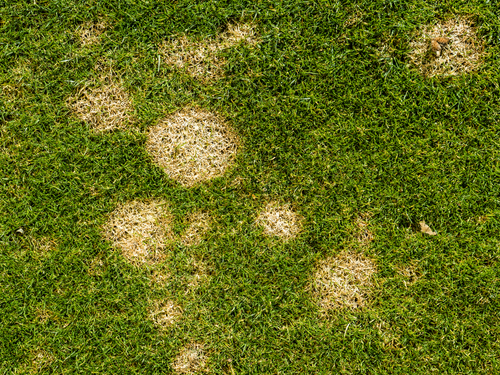
Unfortunately, there isn’t a straightforward answer to yellow patches on your lawn. This is pretty much why we’re going to cover the possible causes and how to overcome them.
Yellow patches can result from too little water or too much fertiliser. Or too few nutrients and too much water. Pets and local wildlife can be the culprits as well.
Luckily, this comprehensive article covers the fourteen most common causes of yellow patches. Do you recognise any of these?
Yellow patches #1: too little water
Probably the most common (and most easily remedied) of all causes of yellow patches on a lawn is a lack of irrigation.
Before you rule this out, consider your soil type. In other words, if you have light or sandy soil, it doesn’t matter how much rain your garden gets: it won’t hold onto water.
You may be experiencing a period of drought, or it could be that your soil can’t hold onto its moisture. The most obvious answer to yellow patches on your lawn is too little water.
So, check below the soil surface. If the earth is dry down to 10cm, it definitely needs more water.
TIP: Improve the water retention of sandy soil by mixing in well-rotted organic matter, such as compost or manure.
Yellow patches #2: too much water
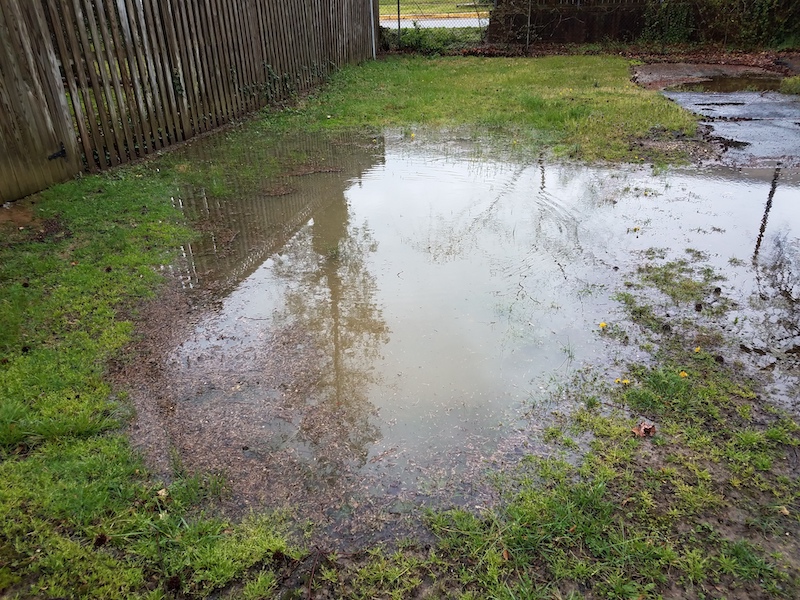
Sandy soil is unlikely to suffer from too much water. But heavy clay soil can turn its turf yellow because the earth is too wet.
Healthy turf requires sunlight, water, and oxygen. And waterlogged soil starves your grass plants’ roots of oxygen.
So, if you have heavy water-retentive soil, it will need regular aerating to help oxygen reach the roots while improving drainage. Using an aerator tool is the easiest and quickest way to aerate your soil.
Again, check your soil’s moisture levels. You can’t control the weather, but you can manage your drainage! The easiest way to check moisture is to make a tiny hole and stick your finger into the ground – if it’s waterlogged down to about 3-4cm, get aerating!
Yellow patches #3: your grass is too short
Sure, lawn mowing strengthens your grass plants, encouraging new growth. But if you cut your lawn too short, you actually compromise the plant’s resistance.
Think about it: the grass blades are your plant’s protective layer. So, if you cut away too much, the plant will suffer.
The general rule of thumb is never to cut more than one-third of the total length of the grass blade. Cutting too short is a sure way to develop yellow patches on your lawn.
QUOTE: Mow your grass too short, and it will die, turning the grass blades yellow. After all, you’re removing the plant’s protective layer.
Yellow patches #4: your mower blades are blunt
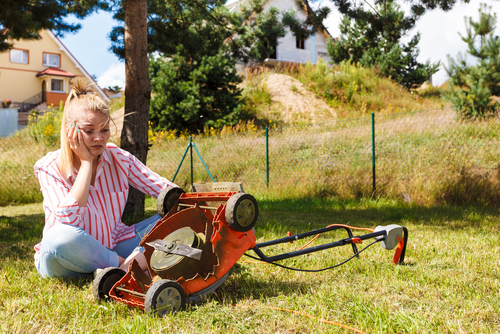
Blunt mower blades tear your grass rather than cut it. A sharp cutter slices precisely through the grass blade, leaving a small wound that quickly heals.
If you tear your grass blades, it leaves a much larger wound, which leaves the plant open to disease and dehydration. Always mow with sharp cutting blades to prevent yellow patches on your lawn.
Yellow patches #5: paddling pools, swimming pools, or gazebos
If you’ve covered a part of your lawn for any period of time with a paddling- or swimming pool, you’ll notice discolouration when you take it down.
Perhaps you’ve invested in a fold-up or inflatable swimming pool or hot tub? They’re great fun during the summer and, chances are, you leave it in situ throughout the summer. Well, this will starve the grass underneath the pool from sunlight and (to a degree) oxygen.
Hot tubs can be particularly damaging for grass if you treat the water with chlorine (as you should!). If chlorinated water comes into contact with grass, you’ve guessed it – it can turn it yellow!
Even sunbeds left out on the lawn for any length of time can affect your grass’s colour. Basically, anything that blocks sunlight from your grass for a significant duration, such as a gazebo, is likely to result in yellow patches when you remove them.
Yellow patches #6: after the winter
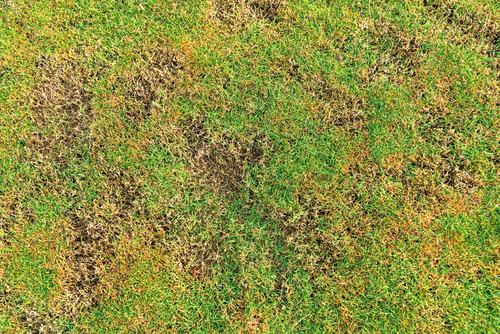
It’s relatively common for yellow patches to appear throughout your lawn after winter. This is because your grass plants go dormant once the soil temperature plummets below 10ºC, and this provides an excellent window of opportunity for fungi, weeds, moss, and disease to take hold, resulting in yellow patches on your lawn.
This is quite normal and part of your lawn’s life cycle. However, repairing winter-damaged grass is a case of developing a good springtime lawn care routine: fertilising and re-sowing the patches that have died off.
Provide your yellowing grass with a good-quality fertiliser and some overseeding, and it will be back to its lush green in just a couple of weeks.
In addition to standard fertilising, iron sulphate can help yellowing grass recover. Find out more about how to use iron sulphate here.
Yellow patches #7: too much fertiliser!
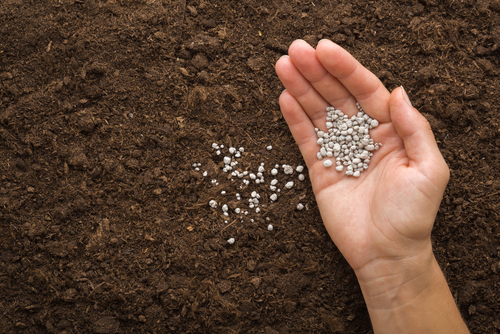
Looking after your lawn is all about balance.
That means you need to fertilise your lawn at least twice a year (we recommend three times), but don’t go crazy. Over-fertilising won’t transform a dwindling lawn into something lush and spectacular.
Over-fertilising forces your lawn to take in too many nutrients – but it won’t be able to process all of them. So, a lot of the nitrogen and salts from the fertiliser sit in the soil, and they can damage your grass plant’s roots (or even kill it!).
Check out our expert’s guide on how and when to fertilise your lawn.
Yellow patches #8: too little fertiliser!
It feels like we can’t win, doesn’t it! You’re damned if you do, and damned if you don’t.
But that’s not the attitude! For a beautiful lawn, it’s essential to fertilise at least three times a year. But pick the right time – early spring, late summer, and an autumn fertilising can boost your lawn’s health and appearance.
If you’re not sure WHICH fertiliser to use, then check out our complete guide to NPK fertilisers. This expert article explains everything you need to know about choosing the correct chemical compounds for your lawn.
Yellow patches #9: Incorrect fertilisation
Some fertilisers can scorch your grass. It’s essential to check the label because some products recommend that you avoid walking on your lawn for a couple of days after applying.
If you discover footprint-sized dark patches on your lawn, it could be that somebody has walked across your grass after you’ve fertilised. It might not be a human – it could be a local cat or a fox.
Always read the label: make sure that your fertiliser is safe for use around animals and children (and adults, of course). MOOWY’s fertiliser range is all safe for animals and humans, and it’s possible to walk on your grass after application without scorching your plants.
The best way to avoid scorching for all fertilisers is to ensure that you water well after applying your fertiliser. This helps the product reach your grass’s roots; rather than allowing it to sit on the grass blades.
Yellow patches #10: acidity
If your soil’s pH is too high, you’re likely to see yellow patches in the grass. High pH levels indicate acidity, but grass thrives with neutral soil (around pH 7).
Acidic soil develops over time due to organic decomposition – fallen leaves, etc., landing on your grass and decomposing. If your lawn is surrounded by acidic plants, such as pine trees or rhododendrons, these can also increase your lawn soil acidity.
Your grass will grow slowly in acidic soil and may die in patches, making your lawn prime real estate for weeds and moss.
You can test your soil’s acidity with a kit and neutralise the pH with garden lime. Check out our article about spreading garden lime.
Yellow patches #11: Pets
We love our pets in the UK, but our beloved cats and dogs could be ruining our lawns. Indeed, those yellow patches could be occurring due to cat or dog urine, both of which contain high levels of nitrogen.
Small amounts of urine can cause a growth spurt due to the nitrogen burst. These areas tend to go darker in colour. But lots of wee is not good for your grass, which is likely to go yellow.
If you spot your pet weeing on your lawn, dilute the nitrogen by watering the area after they’ve finished.
Most animals, however, aren’t forever in your range of sight, especially cats. So, you could think about buying a repellant – either in powder form or a little device – which prevents animals from urinating close by.
Yellow patches #12: Leatherjackets
Leatherjackets are the larvae of crane flies, and they can be a significant lawn pest. They live in the upper layers of the soil and feed on the plant’s roots, causing it to die.
Leatherjackets usually emerge from the soil surface when the weather is damp, especially at night. So, you can spot them crawling around in these conditions.
If you discover an infestation of leatherjackets, you should probably do your best to eradicate them. Check out our article and learn how to overcome a leatherjacket infestation humanely.
Yellow patches #13: grubs
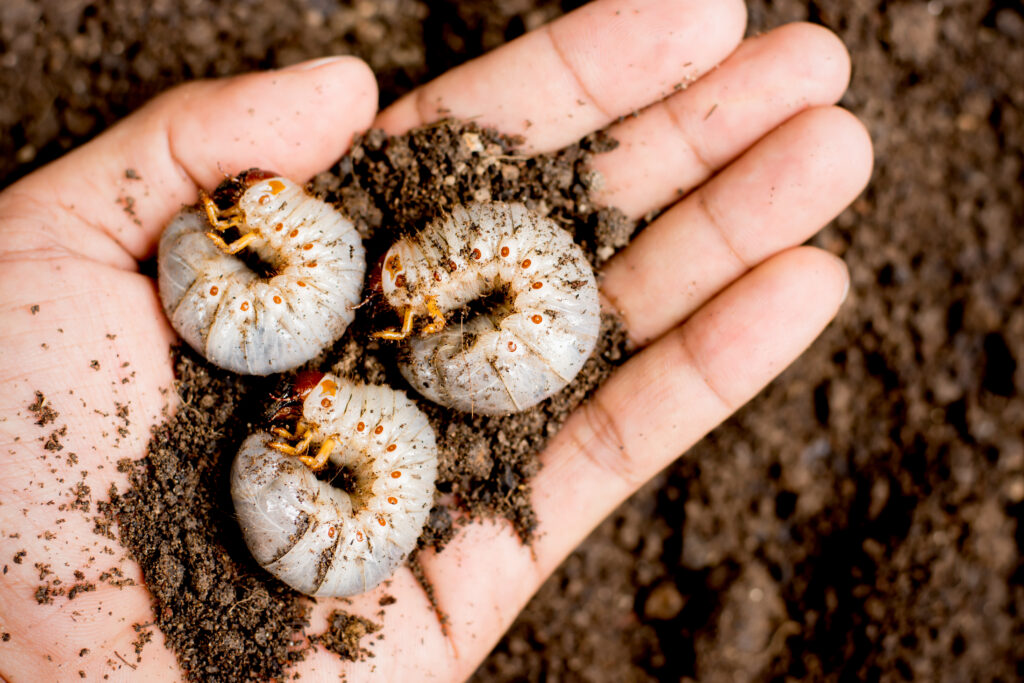
You may discover yellow patches on your lawn if you have an infestation of grubs living in your soil. Chafer grubs are a particular problem, leaving distinct rings of death across your lawn.
Chafer grubs live underground and feed on grass roots. They prefer to live in the dark, so it isn’t easy to spot them during the day.
If you believe you have an infestation of grubs, pour water over yellow patches and their immediate outer circumference – just before sunset. Cover these spots with black plastic and leave them there overnight.
When you remove the black plastic in the morning, you should find the grubs are still sitting on the lawn surface because they haven’t been drawn underground by the emergence of the sun. Then you can pick them out of the grass and dispose of them.
Check out our article about tackling chafer bugs.
Yellow patches #14: fungi
Fungal diseases can appear on your lawn for several reasons:
- Drought
- Overwatering
- Mowing too low
- Compacted soil
- Overuse of fertilisers
- Hot and humid weather
Fungal diseases can be challenging to treat, but you can apply a fungicide. The best way to avoid fungal infections is a good lawn care routine. More about that next:
Restoring yellow patches in your lawn
You might not know which of those possible causes are creating the yellow patches on your lawn, so it’s time to investigate a little further.
Go to the yellow patch on your lawn and touch the grass:
- If the soil is very wet, it’s time to aerate your soil
- If it’s dry, give it some water! This way, the roots burrow deeper into the soil for moisture, strengthening your roots and making your grass more drought resistant. It’s better to water a lot once a week than a little a couple of times a week.
If the soil moisture is neither too wet nor dry, the yellow patch could be a sign of poor nutrition. So, apply a good-quality slow-release fertiliser.
But:
If the grass has already died, clear the ground of the dead blades and prepare the ground for re-sowing some new grass seed. Re-sow as soon as possible to prevent moss and weeds from finding the opportunity to establish.
Preventing yellow patches on your lawn
Prevention, as they say, is better than cure. You do this by adequately maintaining your grass plants. So:
- Fertilise – two to three times a year.
- Water – at least once a week. Grass needs around 4cm of water every week during the growing season.
- Mow – regular mowing helps strengthen your grass plants (as long as the blades are sharp). Remember, never mow more than ⅓ of the grass blade’s length in one go!
- Liming – this helps neutralise acidity and avoid moss and weeds.
- Remove weeds
- Fight pests, such as chafer grubs and leatherjackets.
Ready to get started? Or do you need more information?
We love to hear from you. So, if you have any additional questions about this article or anything else lawn-related, drop us an email. We’ll get back to you as soon as we can!
Thanks for reading.
FAQ
Yellow grass is a sign of low nutrition and can be caused by too little water, too much water, blunt cutting blades on your mower, or lawn diseases. Water your lawn if it’s too dry and aerate your soil if puddles are collecting. Sharpen your cutting blades on your mower for a cleaner cut.
Cutting your lawn with blunt cutting blades tears your grass, leaving a larger wound on the tip of the grass – this leaves it susceptible to disease and drying out. Try and sharpen your cutting blades every year.
Yes. You should avoid cutting your lawn too short unless you have a specialist ornamental lawn (such as MOOWY’s Premium Lawn Seed). Grass plants use the leaves to photosynthesise so, if you cut too short, you stunt your lawn’s ability to feed itself from the power of the sun.
Leave a comment
Your answer will be displayed on the site and the interested party will be notified by email.
Leave a comment
Have a question or want to share your experience? Leave us a comment.
Read more
The best tips and tricks for a lush green lawn
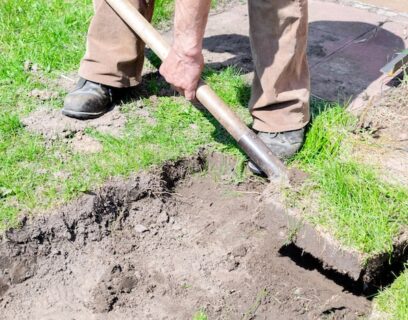 6 MIN
05 Mar
Removing Old Turf: why, when, and how?
6 MIN
05 Mar
Removing Old Turf: why, when, and how?
 7 MIN
10 Feb
Everything You Need to Know About Lawn Sanding
7 MIN
10 Feb
Everything You Need to Know About Lawn Sanding
 Scarifying Kit
All products after scarifying | Quickly restores the lawn after scarifying | Outsmart weeds quickly with the use of this kit
From: € 39.99
Scarifying Kit
All products after scarifying | Quickly restores the lawn after scarifying | Outsmart weeds quickly with the use of this kit
From: € 39.99
 Spring Lawn Care Kit
MOOWY’s choice for the spring | Quick recovery of your lawn after winter | A strong lawn prevents weeds
From: € 25.99
Spring Lawn Care Kit
MOOWY’s choice for the spring | Quick recovery of your lawn after winter | A strong lawn prevents weeds
From: € 25.99
 Long Lasting Lawn Fertiliser
Effective for 90 days | See results in 14 days! | Suitable for all types of grass and soil
From: € 13.99
Long Lasting Lawn Fertiliser
Effective for 90 days | See results in 14 days! | Suitable for all types of grass and soil
From: € 13.99
Do you want a lawn calendar?
🌱 All important maintenance moments for your lawn during the year. Leave your email and we will send you the lawn calendar for free.
Enter your email
Receive the lawn calendar in the mail
Enjoy a green lawn all year round!




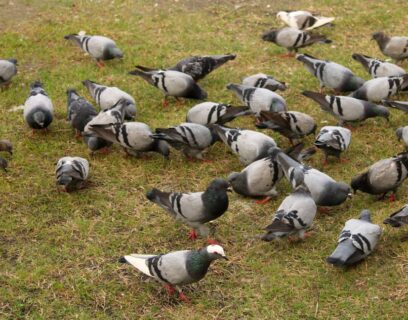





Comments (0)
There are no comments yet. Well then, what are you waiting for to
Be the first to write your comment!inaugurate this pretty page?
Do you have some comments?